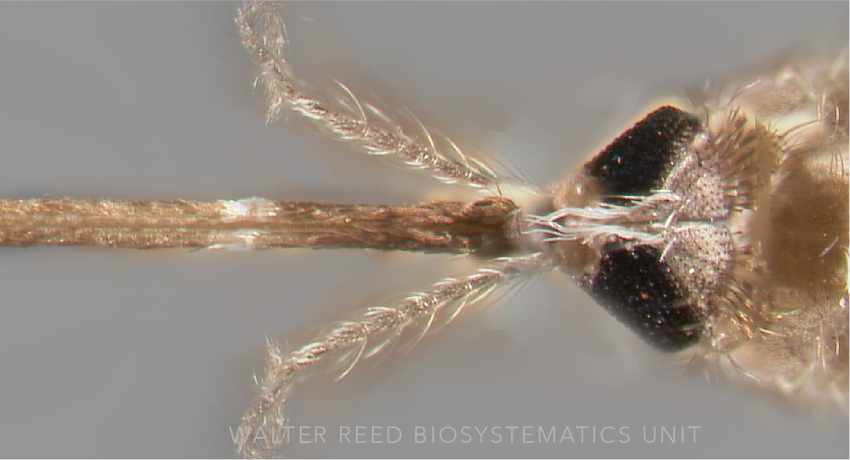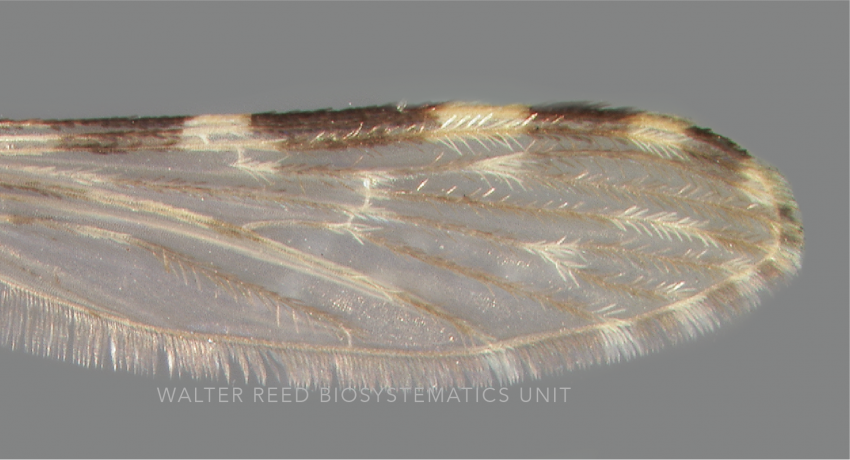AFROTROPICAL REGION
Etymology: not stated [fatal, causing death (L)]
Anopheles funestus is the nominotypical member of both the Funestus Group and Funestus Subgroup. The Funestus Group comprises 23 formally described Afrotropical and Oriental species, and a number of genetically defined taxa, including “funestus-like”. Species in the Funestus Subgroup include: An. aruni Sobti, An. confusus Evans & Leeson, An. funestus, An. funestus-like, An. longipalpis (Theobald), An. parensis Gillies, and An. vaneedeni Gillies & Coetzee. ITS2 rDNA species-diagnostic PCR assays are commonly used to differentiate species of the Funestus Subgroup. There are seven currently valid synonyms for An. funestus s.s. - kumasii Chalmers, hebes Dönitz, umbrosa Theobald, subumbrosa Theobald, anisochloros Theobald, bisignata Grünberg, and imerinensis Monier & Treillard.
Type locality: Freetown, [Sierra Leone]
Type depository: Natural History Museum, London, England, United Kingdom (NHMUK)
DIAGNOSTIC CHARACTERS (Click photos to view; mouse over and click large photo to zoom in.)
ADULT (illustrated): Head: Palpus with three pale bands, including one apically. Wing: No pale spots on the costa basal to sector pale spot; accessory sector pale spot continuous to costa; preapical dark spot without pale interruption, longer than preapical pale spot; vein R all pale basally; no pale fringe at end of vein 1A; vein M3+4 with a pale spot. Legs: Legs not speckled; Ta-III1–5 with very narrow apical pale bands.
LARVA (not illustrated): Head: Setae 2–4-C single. Thorax: Setae 9,10-M long and single; sides of thorax and abdomen not spiculate. Abdominal segments: Tergal plate on segments IV and V wider than distance between palmate setae; tergal plates large, c. 2 x wider than deep; tergal accessory plates usually absent.
TAXONOMIC KEYS
Gillies & Coetzee 1987
Becker et al. 2010
![]()
WRBU - Anopheles - Afrotropical Region - Larva
![]()
WRBU - Genera - Global - Adult
![]()
WRBU - Genera - Global - Larva
![]()
WRBU - Genera - Afrotropical - Adult
![]()
WRBU - Genera - Afrotropical - Larva
Exemplar DNA sequences
An. funestus s.s. COI: JQ424633-85, MG190073–76; ITS2: AF062512;
An. funestus s.s. whole genome: GCA003951495.1
BIONOMICS
Immatures
Generally An. funestus s.s. immatures are found in large, deep bodies of clear water including lakes, ponds, streams, rivers, and ditches—especially where emergent vegetation is present. They can also become locally abundant in rice fields, but only when plants are close to harvest.
Adults
Anopheles funestus s.s. is by far the most competent malaria vector in the Funestus Group. They are highly anthropophilic and strongly endophilic, and like to rest in human dwellings post-feeding. The closely related species An. rivulorum Leeson, An. parensis and An. leesoni Edwards (Afrotropical Funestus Group) are also collected resting indoors. There is some evidence that implementation of indoor residual spray campaigns can result in behavioral modifications in An. funestus. In Toloki, Benin, the proportion of outdoor biting An. funestus s.l. changed from 45% (baseline) to 68.1% after one year of initiation of a deltamethrin indoor residual spray campaign, and the peak biting times switched from 03:00 to 05:00.
DISTRIBUTION NOTES
Angola, Benin, Botswana, Burkina Faso, Burundi, Cameroon, Central African Republic, Chad, Comoros, Congo, Côte d'Ivoire, Democratic Republic of the Congo, Equatorial Guinea, Eritrea, Eswatini, Ethiopia, Gabon, Gambia, Ghana, Guinea, Guinea Bissau, Kenya, Liberia, Madagascar (includes Glorioso & Juan De Nova Is), Malawi, Mali, Mauritania, Mayotte, Morocco, Mozambique, Namibia, Niger, Nigeria, Rwanda, São Tomé & Príncipe, Senegal, Sierra Leone, Somalia, Republic of South Africa, South Sudan, Sudan, Tanzania, Togo, Uganda, Zambia, Tanzania (Zanzibar), Zimbabwe.

WRBU VECTOR HAZARD REPORTS
View other WRBU Vector Hazard Reports
Available GIS Models
IMPORTANT REFERENCES (full citations below)
Giles 1900b: 50 (M, F*)
Macfie & Ingram 1922 (F*)
Ross & Roberts 1943b: 15 (M*, F*, L*; taxonomy, distribution, bionomics)
De Meillon 1947b: 114 (M*, F*, P*, L*, E*)
Service 1960b: 77 (M*, F*, E*; taxonomy)
Gillies & De Meillon 1968: 131 (distribution)
De Meillon et al. 1977 (taxonomy)
Green & Hunt 1980 (chromosomes)
Gillies & Coetzee 1987 (F, L; keys, bionomics, distribution)
Garros et al. 2005a (molecular & morphological taxonomy; sensu lato)
Temu et al. 2007 (taxonomy; sensu lato)
Koekemoer et al. 2009 (molecular taxonomy; sensu lato)
Sinka et al. 2010: 117 (bionomics review, distribution, niche model)
Becker et al. 2010: 322 (F*, L*; key, taxonomy, distribution, bionomics)
Dia et al. 2013 (taxonomy, bionomics; Funestus Group)
Vezenegho et al. 2013 (taxonomy; sensu lato)
Kyalo et al. 2017 (distribution; sub-Saharan Africa)
Kyalo et al. 2017 (distribution; sub-Saharan Africa; as sensu lato)
CURRENT SYNONYMS
syn. kumasii Chalmers
1900: 1262 (M, F). Type locality: Kumasi, Ashanti, Gold Coast [Ghana] (NE).
syn. hebes Dönitz
1902: 84 (A*). Type locality: Dar-es-Salaam [Tanzania] (ZM).
syn. umbrosa Theobald
1903a: 34 (A; funestus variety). Type locality: Gambia (NHMUK). References: Evans 1938: 145 (synonymy); Townsend 1990: 145 (type information).
syn. subumbrosa Theobald
1903a: 34 (F*; funestus variety). Type locality: Gambia (NHMUK). References: Townsend 1990: 138 (type depository).
syn. anisochloros Theobald
1903c: pl. VI, Fig. 4 (A*; as funestus variety). Type locality: Gambia (NHMUK). References: Evans 1938: 145 (synonymy); Townsend 1990: 43 (type information).
syn. bisignata Grünberg
1905: 378 (F*; Myzomyia). Type locality: Kete Kratje, Togo [Ghana] (ZM). References: Evans 1938: 145 (? syn.).
syn. imerinensis Monier & Treillard
1935: 572 (F). Type locality: Tananarive, Madagascar (LU). References: De Meillon 1947b: 125 (taxonomy); Doucet 1951b: 68 (A); White 1980: 118 (from variety of funestus).
CITED REFERENCES
Becker, N., Petrić, D., Zgomba, M., Boase, C., Madon, M., Dahl, C., & Kaiser, A. (2010). Mosquitoes and their control (Second ed.). Berlin Heidelberg: Springer-Verlag.
Chalmers, A.J. (1900). Uncomplicated aestivo-autumnal fever in Europeans in the Gold Coast Colony, West Africa. Lancet,2, 1262–1264.
De Meillon, B. (1947b). The Anophelini of the Ethiopian geographical region. Publications of the South African Institute for Medical Research, 10(49), 1–272.
De Meillon, B., Eeden, G.J.V., Coetzee, L., Coetzee, M., Meiswinkel, R., Toit, C.L.N.D., & Hansford, C.F. (1977). Observations on a species of the Anopheles funestus subgroup, a suspected exophilic vector of malaria parasites in northeastern Transvaal, South Africa. Mosquito News, 37(4), 657–661.
Dia, I., Guelbeogo, M.W., & Ayala, D. (2013). Advances and perspectives in the study of the malaria mosquito Anopheles funestus. In S. Manguin (Ed.), Anopheles Mosquitoes-New Insights Into Malaria Vectors (pp. 197–220). Janeza Trdine 9, 51000 Rijeka, Croatia: InTech.
Dönitz, W. (1902). Beitrage zur Kenntniss der Anopheles. Zeitschrift fur Hygiene, 41, 15–88.
Evans, A.M. (1938). Mosquitoes of the Ethiopian Region. II. Anophelini adults and early stages. London: British Museum (Natural History).
Garros, C., Harbach, R.E., & Manguin, S. (2005a). Morphological assessment and molecular phylogenetics of the Funestus and Minimus groups of Anopheles (Cellia). Journal of Medical Entomology, 42(4), 522–536.
Giles, G.M. (1900b). Description of two species of Anopheles from West Africa. Liverpool School of Tropical Medicine Memoir, 2, 49–51.
Gillies, M.T., & Coetzee, M. (1987). A supplement to the Anophelinae of Africa south of the Sahara (Afrotropical Region). Publications of the South African Institute for Medical Research, 55, 1–143.
Gillies, M.T., & de Meillon, B. (1968). The Anophelinae of Africa, south of the Sahara (Ethiopian zoogeographical region). Publications of the South African Institute for Medical Research, 54, 1–343.
Green, C.A., & Hunt, R.H. (1980). Interpretation of variation in ovarian polytene chromosomes of Anopheles funestus Giles, A. parensis Gillies, and A. aruni. Genetica (Dordrecht), 51(3), 187–195.
Grünberg, K. (1905). Zur Kenntnis der Culicidenfauna von Kamerun und Togo. Zoologischer Anzeiger, 29, 377–390.
Hay, S.I., Sinka, M.E., Okara, R.M., Kabaria, C.W., Mbithi, P.M., Tago, C.C., …Godfray, H.C.J. (2010). Developing global maps of the dominant Anopheles vectors of human malaria. PLoS Medicine, 7(2): e1000209.
Koekemoer, L.L., Misiani, E.A., Hunt, R.H., Kent, R.J., Norris, D.E., & Coetzee, M. (2009). Cryptic species within Anopheles longipalpis from southern Africa and phylogenetic comparison with members of the An. funestus group. Bulletin of Entomological Research, 99(1), 41–49.
Kyalo, D., Amratia, P., Mundia, C.W., Mbogo, C.M., Coetzee, M., & Snow, R.W. (2017). A geo-coded inventory of anophelines in the Afrotropical Region south of the Sahara: 1898–2016. Wellcome Open Research, 2, 57.
Macfie, J.W.S., & Ingram, A. (1922). On the genital armature of the female mosquito. Annals of Tropical Medicine and Parasitology, 16, 157–188.
Monier, H., & Treillard, M. (1935). Anopheles (Myzomyia) funestus var. n. de Madagascar. Bulletin de la Société de pathologie exotique (Paris), 28, 572–573.
Ross, E.S., & Roberts, H.R. (1943b). Mosquito atlas. Part II. Eighteen old world anophelines important to malaria. The American Entomological Society, The Academy of Natural Sciences, Philadelphia, USA.
Service, M.W. (1960b). A taxonomic study of Anopheles funestus funestus Giles (Diptera: Culicidae) from Southern and Northern Nigeria, with notes on its varieties and synonyms. Proceedings of the Royal Entomological Society (B), 29, 77–84.
Temu, E.A., Minjas, J.N., Tuno, N., Kawada, H., & Takagi, M. (2007). Identification of four members of the Anopheles funestus (Diptera: Culicidae) group and their role in Plasmodium falciparum transmission in Bagamoyo coastal Tanzania. Acta Tropica, 102(2), 119–125.
Theobald, F.V. (1903a). A monograph of the Culicidae of the World (Vol. 3). London: British Museum (Natural History). 359pp.
Theobald, F.V. (1903c). Report on a collection of mosquitoes or Culicidae, etc., from Gambia, and descriptions of new species. Liverpool School of Tropical Medicine Memoir, 10.
Townsend, B.C. (1990). A catalogue of the types of bloodsucking flies. Culicidae. Occasional Papers of the Natural History Museum (London), 7, 35–152.
Vezenegho, S.B., Chiphwanya, J., Hunt, R.H., Coetzee, M., Bass, C., & Koekemoer, L.L. (2013). Characterization of the Anopheles funestus group, including Anopheles funestus-like, from Northern Malawi. Transactions of the Royal Society of Tropical Medicine and Hygiene, 107(12), 753–762.
CITE THIS PAGE
Walter Reed Biosystematics Unit (Year). Anopheles funestus species page. Walter Reed Biosystematics Unit Website, http://wrbu.si.edu/vectorspecies/mosquitoes/funestus, accessed on [date (e.g. 03 February 2020) when you last viewed the site].









































































































































































